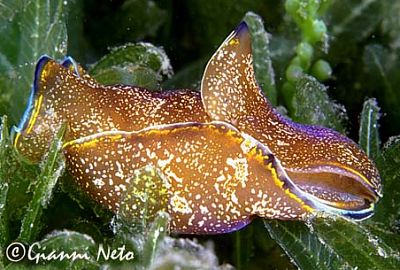
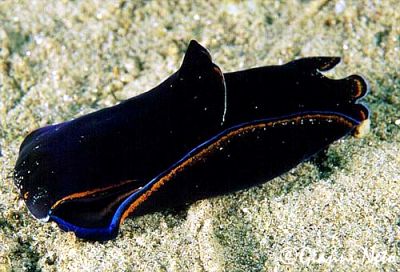
Philinopsis depicta
(Renier, 1807)
Order: CEPHALASPIDEA
Superfamily: PHILINOIDEA
Family: Aglajidae
DISTRIBUTION
Mediterranean
PHOTO
UPPER: 6cm, 10m depth, 1998, Reggio Calabria, Italy - divesite "unrecorded". LOWER: 6cm, 20m depth, 1999, Reggio Calabria, Italy, divesite "City". PHOTOS: Gianni Neto.
Growing to 60mm or more this species is very variable in colour with much the same colour variation as found in the Indo-West Pacific species Philinopsis cyanea.
See justification for moving this species from the genus Aglaja to Philinopsis.
References:
• Gosliner, T.M. (1980) Systematics and phylogeny of the Aglajidae (Opisthobranchia: Mollusca). Zoological Journal of the Linnean Society, 68(4): 325-360.
• Martinez, E., Ballesteros, M., Avila, C., Dantart, L. & Cimino, G. (1993) The family Aglajidae (Opisthobranchia: Cephalaspidea) in the Iberian Peninsula. Iberus, 11(1): 15-29.
• Rudman, W.B. (1972) A comparative study of the genus Philinopsis Pease, 1860. (Aglajidae, Opisthobranchia). Pacific Science, 26(4): 381-99, 15 figs, 1 plate.
• Rudman,W.B. (1974) A comparison of Chelidonura, Navanax and Aglaja with other genera of the Aglajidae (Opisthobranchia, Gastropoda). Zoological Journal of the Linnean Society, 54(3): 185-212.
Rudman, W.B., 2001 (December 6) Philinopsis depicta (Renier, 1807). [In] Sea Slug Forum. Australian Museum, Sydney. Available from http://www.seaslugforum.net/find/agladepi
Related messages
Philinopsis depicta from the eastern Mediterranean
May 14, 2009
From: Bogi Cesare
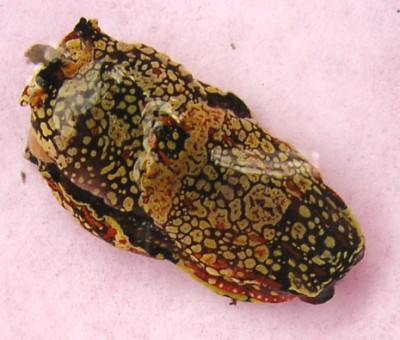
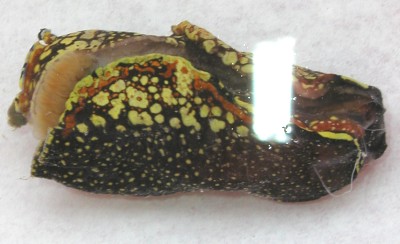
Dear Dr. Rudman,
I send you two photos of a problematic (for me ) species collected in Palmahim (Israel). I suspect it may be Philinopsis depicta but your opinion is very much appreciated.
Many thanks for your kindly help.
Bogi Cesare
Livorno
Italy
bogicesare@tiscali.it
Cesare, B., 2009 (May 14) Philinopsis depicta from the eastern Mediterranean. [Message in] Sea Slug Forum. Australian Museum, Sydney. Available from http://www.seaslugforum.net/find/22464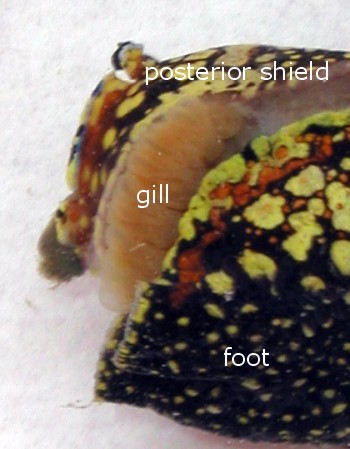
Dear Bogi,
Yes this is Philinopsis depicta.
I have included a close-up from one of your photos to show the gill in the much reduced mantle cavity. Aglajids have a flattened internal shell which is embedded in the 'posterior shield' which extends back from the end of the body. The gill and body openings, such as the anus, reproductive opening and kidney opening are on the underside of this posterior shield. These structures are enclosed by the foot and the parapodial lobes which fold up each side.
Best wishes,
Bill Rudman
Philinopsis depicta from the Mediterranean
May 13, 2009
From: Dominique Horst
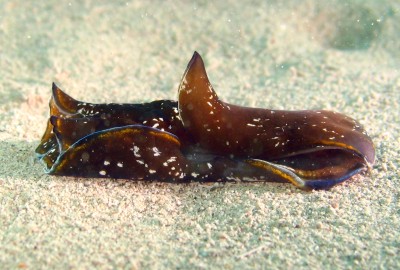
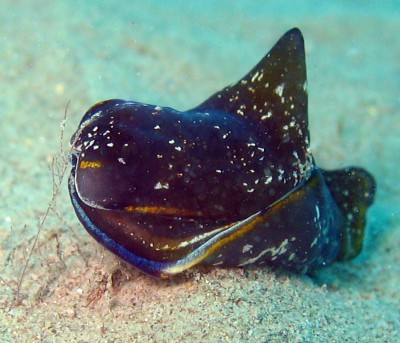
Concerning message #5793:
Hi Bill,
I've finally found my first Philinopsis depicta. It has no flagellum as a 'tail' and looks like an old shoe ...
While I was watching it [middle photo] it made a stop on a hydroid, but then kept on crawling. I remember your message about the fact we don't know yet what Aglaja tricolorata eats. I supposed it's the same case for Philinopsis depicta? I've notice in an earlier message that it can eat Elysia timida....
Locality: Cagnes, 10 m, France, Mediterranean sea, 08/05/2009. Length: 40 mm. Photographer: Dominique Horst.
Kind regards,
Dominique
dominique.horst@wanadoo.fr
Horst, D., 2009 (May 13) Philinopsis depicta from the Mediterranean. [Message in] Sea Slug Forum. Australian Museum, Sydney. Available from http://www.seaslugforum.net/find/22450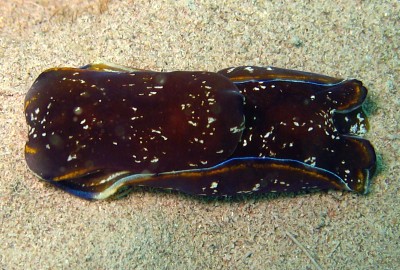
Dear Dom,
Species of Philinopsis feed on a wide variety of bubble-shelled cephalaspideans such as species of Bulla and Haminoea. They also have been reported eating some sacoglossans. We have records on the Forum of P. depicta feeding on Elysia timida and a species of Aglaja in the Caribbean. I suspect there are other records in the literature of it feeding on bubble shells.
As I discussed in your earlier message [#21856], I am still waiting for someone to discover the food of species of the genus Aglaja . Perhaps 2009 will be the year!
Best wishes,
Bill Rudman
Aglajids from Turkey
November 23, 2007
From: Tom Turk
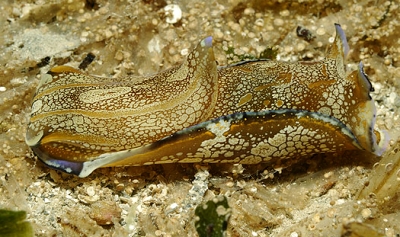
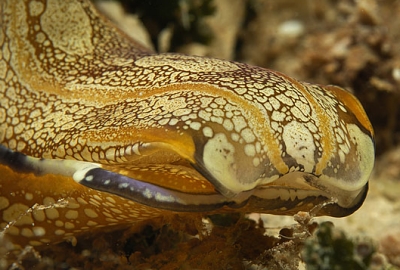
Dear Bill,
Please receive three pictures of two species of aglajids from the coast of Turkey. The smaller one in the lower photo (1 cm) could be Chelidonura fulvipunctata, while the larger one (10 cm), in other photos, is probably Aglaja tricolorata. Could you please confirm.
Locality: kas, 10-15 m, Turkey, Mediterranean, end of October 2007, sandy bottom mixed with sea grass. Photographer: Borut Furlan.
best regards,
Tom Turk
tom.turk@bf.uni-lj.si
Turk, T., 2007 (Nov 23) Aglajids from Turkey. [Message in] Sea Slug Forum. Australian Museum, Sydney. Available from http://www.seaslugforum.net/find/21176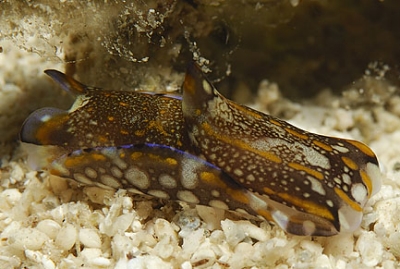
Dear Tom,
These are all photos of the aglajid Philinopsis depicta. In colour they are very similar to Baki Yokes' earlier photo [message #7168] from Turkey. Species of Chelidonura have a quite different shape, in particular the posterior lobes of the body are long and tapering and usually unequal in size.
The more photos I see of P. depicta the more I wonder whether the Indo-West Pacific species, P. cyanea [more properly P. speciosa] is the same species.
Best wishes,
Bill Rudman
Philinopsis depicta color forms
August 27, 2005
From: Anne DuPont
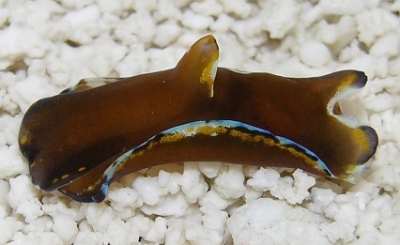
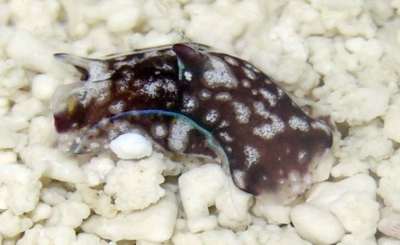
Dear Bill,
In the southern Bahamas this past winter I was able to find and photograph Philinopsis depicta. (Although the numbers were far less than past winters, and the specimens photographed were much smaller than in past years). Here are two color forms.
Upper:The Brown specimen was photographed on December 17, 2005, 6 feet of water, Stocking Island, Exumas, Bahamas and the size was approximately 12mm.
Lower:The spotted specimen was photographed on January 9, 2005, in 5 feet of water at Sand Dollar Beach, Stocking Island, Exumas, Bahamas, and the size was approximately 9mm.
They both were found crawling on the sand during the day.
Cordially,
Anne DuPont
Delray Beach, FL
akdupont@bellsouth.net
DuPont, A., 2005 (Aug 27) Philinopsis depicta color forms. [Message in] Sea Slug Forum. Australian Museum, Sydney. Available from http://www.seaslugforum.net/find/14642Thanks Anne,
Bill Rudman
Variation in Philinopsis depicta from Bahamas
March 25, 2004
From: Marina Poddubetskaia
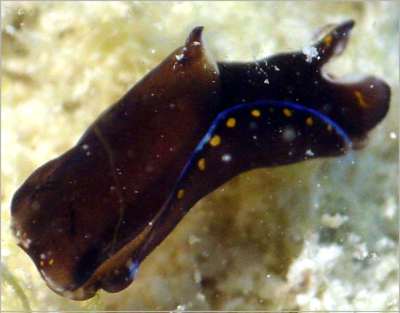
Dear Bill,
I can see that you identified the similar animals sent by Anne DuPont as Philinopsis depicta [message #9650].
When I was with Anne in the Southern Bahamas, we found a lot of these guys and here is a set of photos showing some colour variation in this species. All the specimens were found on shallow sandy bottoms.
Location: Great Exuma, Bahamas, Western Atlantic, Site: Stocking Island, Hole n°2
Depth: 1m. February 1-3, 2004. Length: Upper right - 12-13mm. Centre left - 6-7mm. Centre right - 13-14mm. Lower right - 10mm. Photos: Marina Poddubetskaia - Nembro website
Cordially,
Marina (and Anne).
nembro@nembro.info
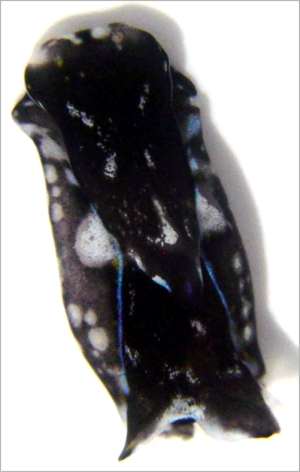
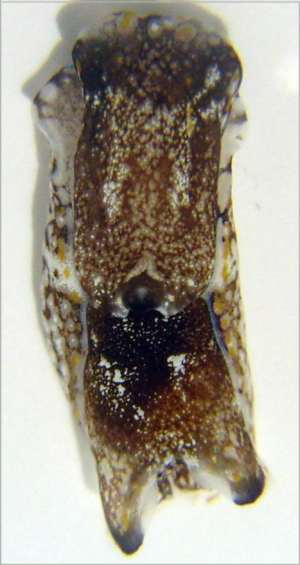
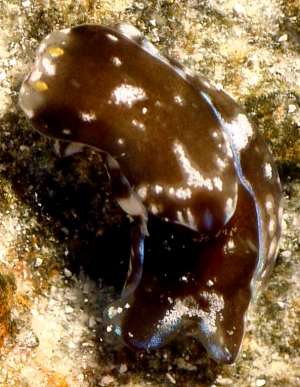
Thanks Marina & Anne,
These animals certainly show the same colour variation as Mediterranean animals do. This is a useful confirmation of Anne's earlier observations
Best wishes
Bill Rudman
Philinopsis depicta eating Aglaja felis
March 25, 2004
From: Marina Poddubetskaia
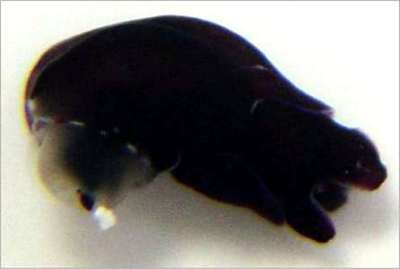
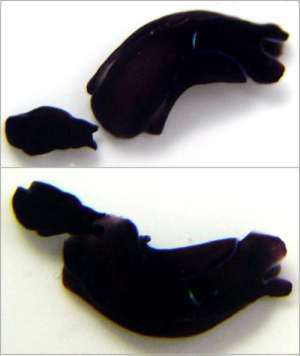
Dear Bill,
In the Southern Bahamas, Aglaja felis is as common as Philinopsis depicta, but difficult to photograph because it is completely black. I tried there a small experiment: I put an Aglaja felis in the presence of a Philinopsis depicta. The result was very fast: Aglaja was eaten in less than 1 min.
Date: February 04, 2004
Location: Great Exuma, Bahamas, Western Atlantic
Site: Stocking Island, Sand Dollar Beach
Depth: 1m
Philinopsis size: 7-8mm
Photos: Marina Poddubetskaia - Nembro website
Best wishes,
Marina.
nembro@nembro.info
Poddubetskaia, M., 2004 (Mar 25) Philinopsis depicta eating Aglaja felis. [Message in] Sea Slug Forum. Australian Museum, Sydney. Available from http://www.seaslugforum.net/find/12520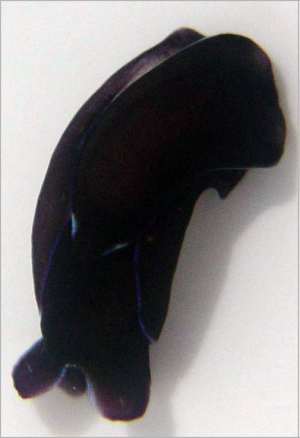
Dear Marina,
Thanks for this interesting observation. I am sure the Aglaja felis will be comforted to know that its sacrifice was not made in vain.
Best wishes
Bill Rudman
Philinopsis depicta from Turkey
September 29, 2003
From: Haluk Akbatur
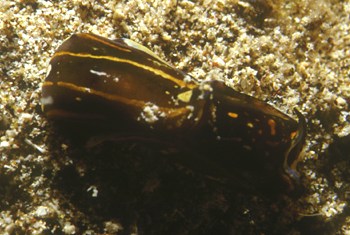
Dear Bill,
Here is a photograph of opisthobranch I think is Philinopsis depicta. It was taken by Adnan Büyük at Ucadalar, East coast of Turkey. This species is quite variable in colour and pattern. Could you confirm the identification please
Dive site: Uc adalar, Depth: 13-25m. on a grass-sandy bottom.
Haluk Akbatur
lasergoz@ttnet.net.tr
Akbatur, H., 2003 (Sep 29) Philinopsis depicta from Turkey. [Message in] Sea Slug Forum. Australian Museum, Sydney. Available from http://www.seaslugforum.net/find/10274Dear Haluk,
I would agree with your identification
Best wishes
Bill Rudman
Philinopsis depicta from Tunisia
May 5, 2003
From: Anis
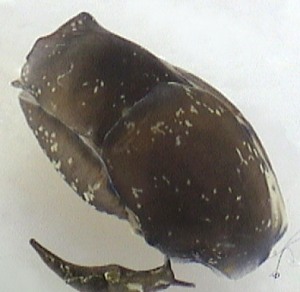
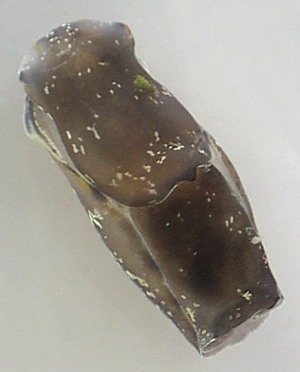
Dear Bill,
I found this sea slug in a coastal lagoon, "Lac de Tunis" (southern setion) in Tunis, Tunisia, North Africa. Depth: 0 to 1m some time between January and March, 2003.
Can you identify it please.
Thanks,
Anis.
bensouissi.jamila@inat.agrinet.tn
Anis, 2003 (May 5) Philinopsis depicta from Tunisia. [Message in] Sea Slug Forum. Australian Museum, Sydney. Available from http://www.seaslugforum.net/find/9689Dear Anis,
This is Philinopsis depicta, a cephalaspidean or 'bubble shell'. It is usually found burrowing in soft sediments and feeds on other cephalaspideans. As you will see from other photos on this page it is usually more brightly coloured than this, but in the lower photo, you can see slight traces of orange on the anterior edge of the head and the edge of the parapodia.
Best wishes,
Bill Rudman
Aglaja depicta or Philinopsis depicta
April 14, 2003
From: Bill Rudman
In Anne Du Pont's message I discuss the generic placement of Aglaja depicta and refer to an earlier message where I explain why I continue to place this species in Aglaja. To summarise this discussion, In earlier reviews of the family Aglajidae (Rudman, 1972, 1974) I defined the anatomical characters needed to separate the various genera in the family. Terry Gosliner (1980) added to this work, and suggested some modifications most of which I agree with. One point I have had difficulty in accepting is the move of Aglaja depicta to the genus Philinopsis. Many internal and external features of the two genera are very similar but one very unique feature of species of Aglaja is the exogenous sperm sac opening into the spermoviduct rather than into the genital vestibule. In published anatomical work Aglaja depicta has this character, and in the absence of any other convincing evidence I feel it should remain in that genus, until its anatomy has been re-examined. I have just discovered an anatomical description of the reproductive system of this species (Martinez et al, 1993) in which the illustration clearly shows the a Philinopsis - like arrangement of the exogenous sperm sac. It also shows a penial anatomy very similar to that of Philinopsis cyanaea.
As I said in Anne's message, this is the information I needed, so I have no hesitation now in moving the species to Philinopsis. It certainly raises the question about whether P. cyanea is just an Indo-West Pacific form of P. depicta.
References:
• Gosliner, T.M. (1980) Systematics and phylogeny of the Aglajidae (Opisthobranchia: Mollusca). Zoological Journal of the Linnean Society, 68(4): 325-360.
• Martinez, E., Ballesteros, M., Avila, C., Dantart, L. & Cimino, G. (1993) The family Aglajidae (Opisthobranchia: Cephalaspidea) in the Iberian Peninsula. Iberus, 11(1): 15-29.
• Rudman, W.B. (1972) A comparative study of the genus Philinopsis Pease, 1860. (Aglajidae, Opisthobranchia). Pacific Science, 26(4): 381-99, 15 figs, 1 plate.
• Rudman,W.B. (1974) A comparison of Chelidonura, Navanax and Aglaja with other genera of the Aglajidae (Opisthobranchia, Gastropoda). Zoological Journal of the Linnean Society, 54(3): 185-212.
Best wishes,
Bill Rudman
Aglaja depicta? from the Caribbean
April 9, 2003
From: Anne DuPont
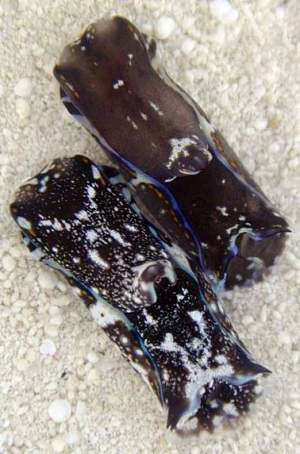
Hi Bill,
How are you and things at the museum? I need your help once again to identify a nudibranch I found in the Bahamas this winter.
Here is a little background:
I found them over a range of 100 miles in the Southern Bahamas (The Exumas chain of islands) in depths from 2 feet to 10 feet.
Their size was 1/8 inch to about 1 inch long.
They were crawling on the sand in the day, and when my strobe would fire, they would bury in the sand. They were quite active.
They varied in color from dark brown to medium brown, and brown and white speckled.
These photographs were taken on January 17, 2003, and I saw many on each snorkel dive during January, February and March. And everywhere I found them, there were lots of Chelidonura hirundinina in the same area, sometimes both nudibranchs would be a few feet apart. Is this an Atlantic "Philinopsis cyanea"?
Thank you for your time and the wonderful Forum.
Cordially,
Anne DuPont
Delray Beach, Fl
akdupont@bellsouth.net
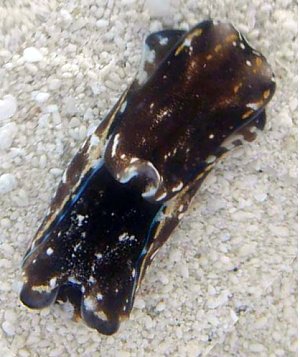
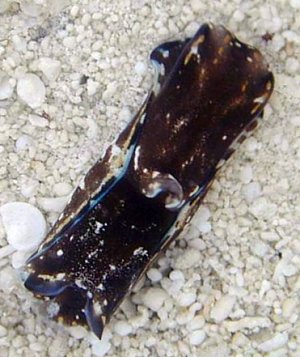
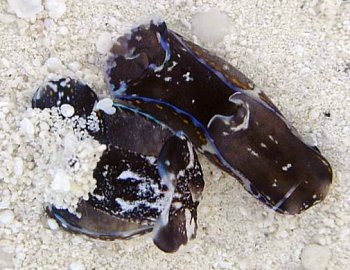
Dear Anne,
This is another interesting find. It's a good example of how little we know about even the most abundant animals. Certainly if I found these in the Indo-West Pacific I would immediately identify them as a colour form of P. cyanea, and it may turn out on investigation that they are a Caribbean population of that species. At this stage though I have tried to identify them with a species known from the Atlantic region.
Marcus & Marcus (1967) described Aglaja pusa from a single preserved specimen collected in Key Biscayne, Florida. It was 45mm long preserved, and its preserved colour was described as 'greyish black interrupted by numerous pigment-free spots of various sizes, some oblong, some round with a dark centre. Fusion of these light areas produces local vermiculated designs'. The shape of the penis fits my description (Rudman, 1972) of P. cyanea. The colour of your animals are consistent with Marcus' description of their A. pusa. However if we look at photos of Aglaja depicta from the Mediterranean, I suspect your animals are probably identical. This raises the question I discuss in an earlier message concerning what genus A. depicta really belongs to. If it is really a Philinopsis, then perhaps P. cyanea and A. depicta are one circum-global species. What is sadly lacking is a re-examination of the anatomy of A. depicta. Until we know the detailed anatomy of the reproductive system and the penis it is not possible to determine its generic placement.
In summary, I think this is probably the first record of A. depicta in the Caribbean, I suspect A. pusa is a synonym, and it would be nice to know a little more detail about the reproductive system of A. depicta.
References:
• Marcus, Er. & Marcus, Ev. (1967) American opisthobranch mollusks. Part 1, Tropical American opisthobranchs. Studies Tropical Oceanography, Miami, 6(1-2): 1-137. (Figs 1-150, Pl.1, figs 1-9)
• Rudman, W.B. (1972) A comparative study of the genus Philinopsis Pease, 1860. (Aglajidae, Opisthobranchia). Pacific Science, 26(4): 381-99, 15 figs, 1 plate.
• Rudman,W.B. (1974) A comparison of Chelidonura, Navanax and Aglaja with other genera of the Aglajidae (Opisthobranchia, Gastropoda). Zoological Journal of the Linnean Society, 54(3): 185-212.
Best wishes,
Bill Rudman
Lunch menu for Aglaja depicta
June 10, 2002
From: Baki Yokes
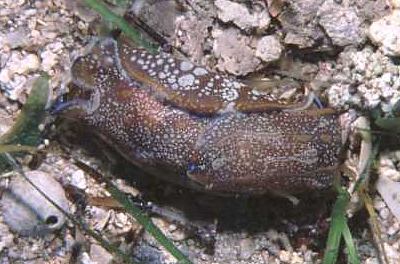
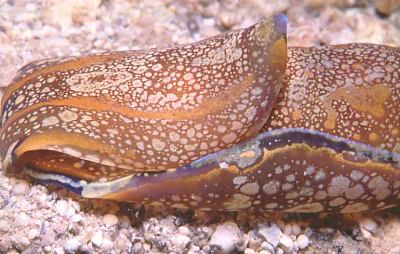
Dear Bill,
Here are the photos of Aglaja depicta. We have collected one of them to take more detailed pictures in the aquarium, and placed it together with some other slugs in the tank. But we soon realized that, all of a sudden, an Elysia timida specimen disappeared, without leaving any trace behind. I think Aglaja depicta ate it.
photos: Baki Yokes
Date: 1 May 2002
Place: Antalya, Turkey
Dive site: Uc Adalar
Depth: 18m, on sand
Size: 8cm
Best wishes
Baki
bakiyokes@turk.net
Yokes, B., 2002 (Jun 10) Lunch menu for Aglaja depicta. [Message in] Sea Slug Forum. Australian Museum, Sydney. Available from http://www.seaslugforum.net/find/7168Thanks Baki,
Carnivorous sea slugs are always a problem in captivity. I suspect it has never eaten a sacoglossan in its life before - but the temptation was just too much for it.
Best wishes,
Bill Rudman
Aglaja depicta from the Mediterranean
December 10, 2001
From: Erwin Köhler


Dear Bill,
Here are 2 shots of Philinopsis depicta from the Mediterranean Sea by Gianni Neto [Email: gianeto@libero.it]
The upper photo shows the common variant of Philinopsis depicta, the other one is almost black - or is it something else?
data:
UPPER PHOTO: 6cm, 10m depth, 1998, Reggio Calabria, Italy - divesite "unrecorded"
LOWER PHOTO: 6cm, 20m depth, 1999, Reggio Calabria, Italy, divesite "City"
Erwin
Erwin@medslugs.de
Köhler, E., 2001 (Dec 10) Aglaja depicta from the Mediterranean. [Message in] Sea Slug Forum. Australian Museum, Sydney. Available from http://www.seaslugforum.net/find/5793Dear Erwin & Gianni,
Thanks for these photos of 'Philinopsis' depicta which show the shape and colour variation so well. I had always thought, from written descriptions, that this species was very similar in colour to the Indo-West Pacific species Philinopsis cyanea and these photos certainly support that idea.
I was interested in seeing you placing this species in the genus Philinopsis rather than Aglaja. Many years ago I reviewed the family Aglajidae (Rudman, 1974) and sorted out a number of anatomical characters to separate the various genera in the family. Terry Gosliner (1980) added to this work, and suggested some modifications most of which I agree with. One point I have had difficulty in accepting is the move of Aglaja depicta to the genus Philinopsis. many internal and external features of the two genera are very similar but one very unique feature of species of Aglaja is the exogenous sperm sac opening directly into the spermoviduct rather than into the genital vestibule. Aglaja depicta has this character, and in the absence of any other convincing evidence I feel it should remain in that genus, rather than be considered an aberrant member of the genus
species of Philinopsis to the Indo-West Pacific.
• Gosliner, T.M. (1980) Systematics and phylogeny of the Aglajidae (Opisthobranchia: Mollusca). Zoological Journal of the Linnean Society, 68(4): 325-360.
• Rudman, W.B. (1974) A comparison of Chelidonura, Navanax and Aglaja with other genera of the Aglajidae (Opisthobranchia, Gastropoda). Zoological Journal of the Linnean Society, 54(3): 185-212.
Best wishes,
Bill Rudman
